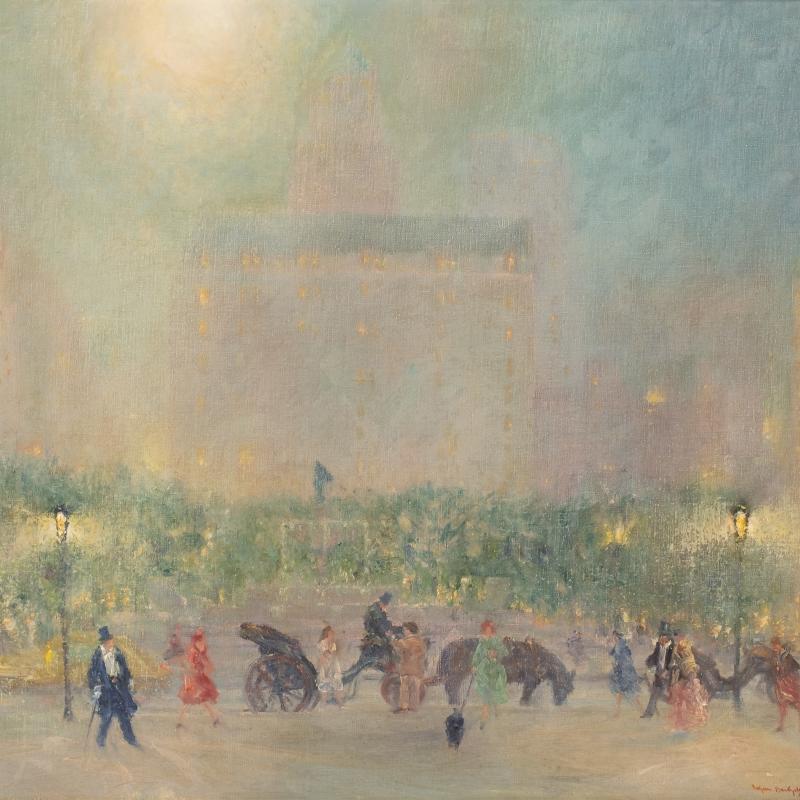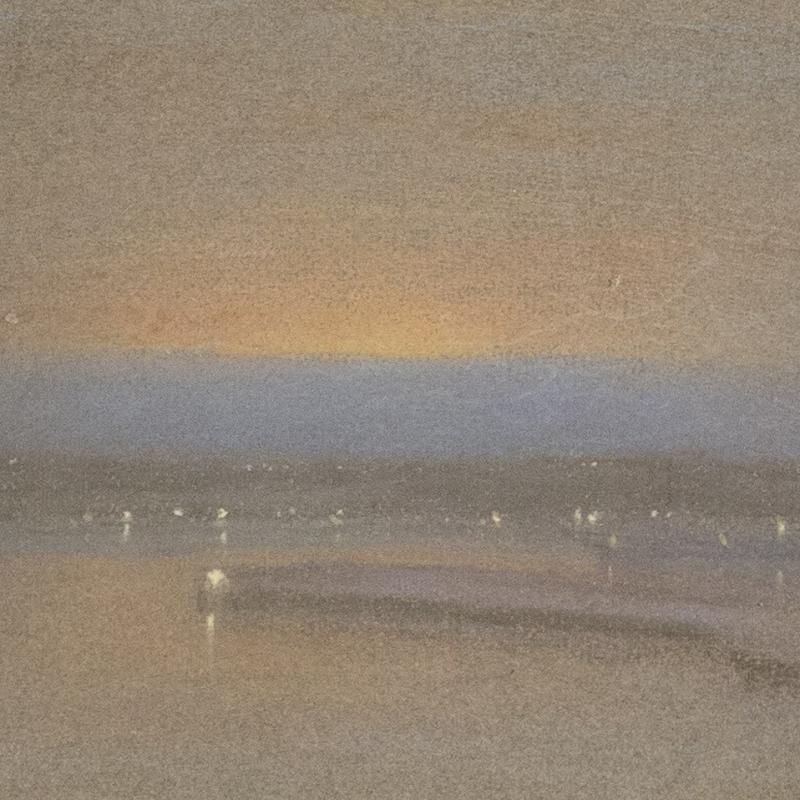-
 Johann BerthelsenSummer Evening, The Plaza, New York City, 1948Oil on canvas25 1/2 x 30 inches,
Johann BerthelsenSummer Evening, The Plaza, New York City, 1948Oil on canvas25 1/2 x 30 inches,
Framed: 37 1/4 x 32 1/4 inchesSigned: Johann Berthelsen (l.r.) and signed, titled, dated (verso)
-
 Johann BerthelsenSunset RiverPastel on paper5 5/8 x 9 3/8 inches,
Johann BerthelsenSunset RiverPastel on paper5 5/8 x 9 3/8 inches,
Framed: 14 x 17 inchesSigned: Johann Berthelsen lower left and again with title on verso
Overview
Johann Henrik Carl Berthelsen is a late American Impressionist painter best known for his large exquisitely rendered cityscapes especially of New York City in the winters which were often compared to the works of Guy Wiggins and Childe Hassam. Ironically Berthelsen's first artistic passion was music and not art. Eventually he combined his love of music with his love for art and often referred to his snowscapes as "painted orchestrations" of Manhattan.
Today Berthelsen is one of the most popular painters of New York City, and consequently his paintings have become difficult to find because of the great demand for them.
Johann Berthelsen was born in Copenhagen, Denmark on July 25, 1883 and at the age of six immigrated to America with his family. By 1901 he had a full scholarship to study voice at the Chicago Musical College owned by the Ziegfeld family during this golden age of opera. He graduated in 1905. He had trained as a baritone and toured the United States and Canada for approximately five years performing grand opera, light opera and Gilbert and Sullivan pieces. In 1910 he joined the faculty of the Chicago Musical College and taught voice there for three years.
Although it was not until 1932 that Berthelsen decided to devote himself fully to art, he had been painting for twenty-two years. He moved to Indianapolis in 1913 to become head of the voice department of the Indianapolis Conservatory of Music. By 1915 he left this position to open his own studio to teach voice and diction. He was a director of the Little Theater Society. He was active within this organization and is reported to have appeared in many of the lead roles.
While in Indianapolis, Berthelsen started painting with Wayman Adams (1883 - 1959), who became Berthelsen's instructor and inspiration. Adams was an Indiana born painter who became a member of the National Academy of Design in New York City. He painted portraits of many artists, governors and luminaries and about twenty of Berthelsen.
Adams held Berthelsen's talent in high regard and said "It is always a pleasure to see a picture that is not merely technical but contains some interest and feeling of an artist for his subject. The intangibly felt nocturnes of Central Park, the romantic streets of New York on a snowy day, or an early spring morning by Johann Berthelsen, give me great delight. Over many years I have watched the consistent poetic quality of his work and rejoice in his mounting success."
Berthelsen had moved to New York City and opened a studio in 1920 at 200 West 57th Street in the Rodin Studios. He taught voice and painted there. The reason there are so many views of twilight by the artist is that he would teach voice during the day and at days end venture outside to paint. By 1932 at the age of forty-nine, he decided to devote himself to painting full-time. The exception was between 1940 and 1942 when he became a member of the Lecture Bureau of the Columbia Broadcast System during the war. This was perhaps his contribution to the war effort.
In 1942 Berthelsen decided to move his family to New Milford, Connecticut and painted still lifes and landscapes of the surrounding areas. After his children grew up, Berthelsen moved back to New York with his wife in 1950 and continued to paint till 1970.
Berthelsen became involved in the New Deal art projects of the mid-1930s. He exhibited at the temporary galleries of the Municipal Art Committee of New York City in 1936. The exhibition was based upon the MacDowell Plan. The MacDowell Plan was when a resident artist of New York could show if a specified number of peers agreed to exhibit with him. Berthelsen's acceptance by this group, no doubt, was encouraging as was the special opportunity to exhibit and sell his paintings.
Few of Berthelsen's early paintings have been located. Scarcer than the early paintings, no pastels or watercolors of Berthelsen's Indiana period have been located. He did, however, work in both media in New York during the 1920's. He drew sensitive pastel cityscape nocturnes in the manner of Whistler as well as other compositions of the city. His first official recognition was for a pastel of Central Park, entered in the Hoosier Salon Exhibition in Chicago (1928), which won the Albert Erskine Prize for Pastel.
His work in watercolor gained him membership in the American Watercolor Society in 1926. His paintings start to show his movement toward Impressionism where Berthelsen starts using daubs of color to define objects which take form only when the painting is viewed from a distance.
The painting of cityscapes of metropolitan New York is not unique to Berthelsen. When he moved to New York City such notables as Childe Hassam (1859-1935), Guy C. Wiggins (1883-1962), and Earnest Lawson (1873-1939) were already producing them, as did Indiana-born Glen Cooper Henshaw (1884-1946). Many were snow scenes and some include flags as focal points, a device used then but rarely seen today.
Guy Wiggins was the major painter of New York cityscapes of the era, and it is tempting at first to believe that Berthelsen was merely a follower of his neighbor at 226 West 59th Street. They were the same age and each depicted the contemporary city under a blanket of snow. Both artists used flags and the yellow taxi as subject matter, and each were members of the Salmagundi Club.
Analysis of their work however, shows Wiggins' paintings to be more solidly painted, generally more colorful, and less convincingly atmospheric. Berthelsen frequently painted similar scenes. Five artists were attracted by the subject matter, but there are subtle differences. In the scope of the view, in the handling of the atmosphere, and in the traffic patterns of the vehicles and pedestrians, Berthelsen had a mastery which separated him from his contemporaries.
His pictures were sometimes painted thinly, with little paint, and at other times with impasto, a heavy build-up of paint, depending upon the effect he wanted to achieve. His works are usually signed but rarely dated, which makes the study of his artistic development difficult. In the mid-1950s there were several Bethelsen forgeries appearing on the market. He then decided to stamp the back of sketches or canvases with his name from this point forward.
Johann Berthelsen is a late American Impressionist painter. While he did not study art in France, he had ample opportunity to view French Impressionism on exhibit in New York City, Chicago and elsewhere. His New York paintings consistently approach those of the French Impressionists especially the style of Claude Monet (1840-1926). Berthelsen creates figures that reflect the lessons of the French Impressionist painters in his cityscapes. He also painted the varying atmospheric effects of the same scene depicted at different times was also a trademark of both artists. Berthelsen and Monet both used flags or other color additions to highlight their cityscapes. It seems logical to believe that Monet, directly or indirectly, was Berthelsen's most important artistic influence.
Berthelsen exhibited extensively in New York City, Indianapolis and Chicago, for which he had an affinity after studying and working there for many years. He also produced cityscapes of Chicago in his later years. He also won numerous awards.
For most of his painting career Johann Berthelsen chose to portray life as it unfolded around him in the city daily with all its energy. In a sense these paintings are "time capsules" of a bygone era with their specific dress, locations, and habits of people long ago. His paintings are appeal to an audience even today as they are easy to understand and comfortable to live with.
Johann Berthelsen died in April 1972 at his home in Greenwich, Connecticut.
Memberships
Allied Artists of America
American Watercolor Society, 1926
Hoosier Salon, 1928
Salmagundi Club, 1936
Awards
Chicago, Erskine Prize 1928
Indianapolis, Holcolme Prize 1946
Exhibitions
Hoosier Salon, Chicago, IL
Thurbers Gallery, Chicago, IL
Hoosier Salon, Indianapolis, IN
American Watercolor Society, New York, NY
Barbizon Plaza Galleries, New York, NY
Galleries of the Municipal Art Committee, New York, NY
Gatterdam Gallery, New York, NY
Jean Bohne Gallery, New York, NY
Herbert F. Johnson Museum of Art, Cornell University, Ithaca, NY
(Roads Less Traveled: American Paintings, 1883-1935)
Museums and Public Collections
Hickory Museum of Art, Hickory, NC
Indiana State Museum, Indianapolis, IN
